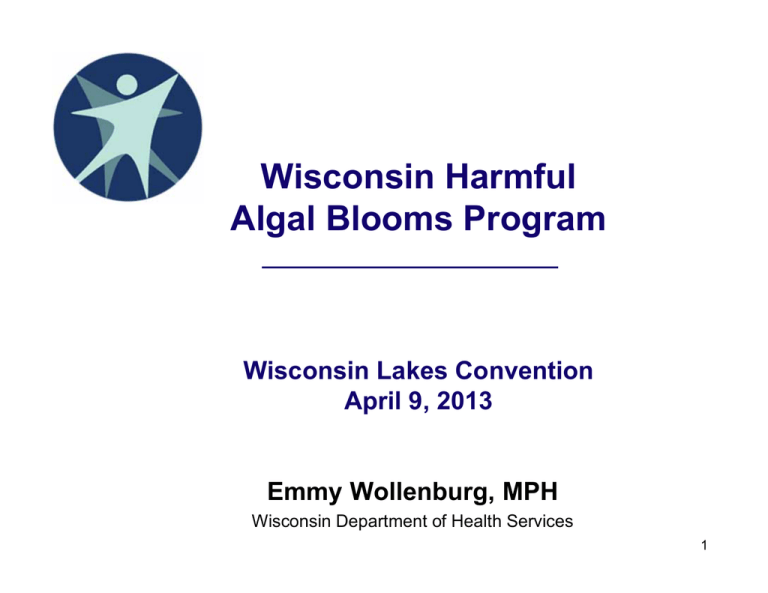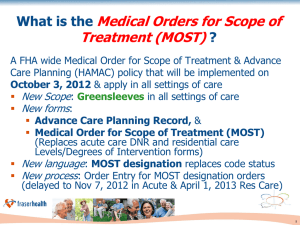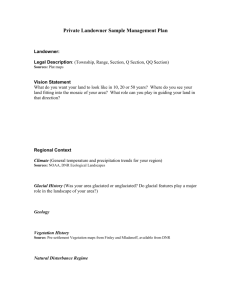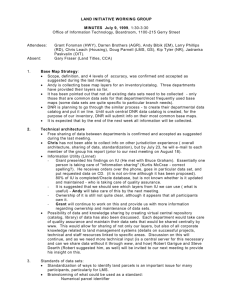Wisconsin Harmful Algal Blooms Program Wisconsin Lakes Convention April 9, 2013
advertisement

Wisconsin Harmful Algal Blooms Program Wisconsin Lakes Convention April 9, 2013 Emmy Wollenburg, MPH Wisconsin Department of Health Services 1 Presentation Overview • Describe the current Harmful Algal Blooms (HAB) program • Discuss routes of exposure and typical symptoms • Provide a summary of 2009-2012 reports of illness • Opportunity for Questions 2 What is the HAB Program at DHS? • Identify, evaluate and report cases of human and animal health events related to cyanobacteria in Wisconsin • Develop outreach capacity to support case reporting and increase awareness of the health issues related to cyanobacteria • Coordinate water sampling with regional DNR staff • This project is supported by a cooperative agreement with the Centers for Disease Control and Prevention 3 How Do We Learn About Illnesses? • Direct contact with Division of Public Health (DPH) staff via e-mail or phone • Report a Case through DPH website dhs.wisconsin.gov/eh/bluegreenalgae • Wisconsin Poison Center (WPC) automated email case notification • Department of Natural Resources (DNR), local public health or lake association referral 4 5 6 7 Partnership with the WI Poison Center (WPC) WPC Receives a HABrelated call Email generated to DPH staff with case description Case report is faxed to DPH DPH contacts caller for full case description WPC sends monthly summary of cases Time Automated Case Reporting Process 8 Response Timeline DHS receives an illness complaint DHS and DNR decide jointly whether an H2O sample in warranted DHS contacts local and state DNR staff H2O sample is analyzed by WI State Lab of Hygiene H2O sample is collected by regional DNR lakes staff DNR provides local public health with H2O results State Lab reports H 2O sampling results back to state-level DNR Time Local public health issues health advisories Pre-beach season: H2O sampling kits are “staged” at regional DNR offices throughout the state 9 Community Outreach • Presentations at local, state and national public health events, local lakes associations, DNR lakes meetings • Educational materials distributed at local and statewide events • YouTube Video 10 Routes of Exposure 1. Skin Contact Direct contact with algae-laden water can cause: • Rash • Hives • Skin blisters (especially on the areas under swimsuits) 11 Routes of Exposure 2. Ingestion Swallowing water where an algal bloom is present can cause: • Abdominal pain • Diarrhea • Vomiting • Nausea • Numb lips, tingling fingers and toes, or dizziness Cases of dog deaths often include salivation, weakness, difficulty breathing and convulsions 12 Routes of Exposure 3. Inhalation Inhaling water droplets (either through irrigation or recreational activities) from water experiencing an algal bloom can cause: • Flu-like illness • Respiratory Irritation (runny eyes and nose, a sore throat) • Asthma-like symptoms 13 Keeping You and Your Pet Safe • Don’t swim where water is discolored or where you see foam, scum or algal mats • Shower after swimming in lakes, rivers and ponds • Keep pets out of soupy, green water or where you see foam, scum, or mats of algae • If dogs swim in scummy water, rinse them off immediately - do not let them lick the algae off their fur • Respect water-body closures and health advisories 14 Routes of Exposure and Case Reporting • Dermal Contact: Direct contact with algae-laden water • Inhalation: Inhaling water droplets (either through irrigation or recreational activities) • Ingestion: Swallowing water where an algal bloom is present Year Health Complaints 2009 37 reports of illness (2 canine) 2010 27 reports of illness 2011 36 reports of illness 2012 33 (4 canine, 1 bovine) Symptoms # of Reports Dermal Rash 31 Respiratory Irritation 24 Gastrointestinal Distress 56 Cold/flu-like illness 37 15 HAB Sampling Response • DNR staff use standardized kits for sampling • Non-standard samples have been received from DNR wardens and from veterinarians Year HAB Sampling Events 2009 13 2010 6 (1 non-standard) 2011 11 (2 non-standard) 2012 13 (2 non-standard) Year High Risk Cells > 100,000/ml Moderate Risk Toxins Detected Cells 20,000100,000/ml 2009 6 3 9 2010 2 1 2 2011 6 3 7 2012 6 3 6 Slide provided by Gina LaLiberte, WI DNR 16 2009-2012 HAB Samples 4 4 2 6 2 2 3 Numbers indicate multiple sampling dates for a single water body. Slide provided by Gina LaLiberte, WI DNR 17 2009-2012 Cyanobacterial Toxins Toxins above detection levels: Microcystins > 1.0 ug/L, or Anatoxin-a > 0.5 ug/L, or Homoanatoxin-a > 0.5 ug/L, or Cylindrospermopsin > 0.5 ug/L, or Deoxycylindrospermopsin > 0.5 ug/L (all in water via HPLC/MS/MS) Microcystin > 0.1 ug/L (via ELISA) 3 3 2 4 2 2 Numbers indicate detection on multiple sampling dates. Slide provided by Gina LaLiberte, WI DNR 18 Questions? 19




